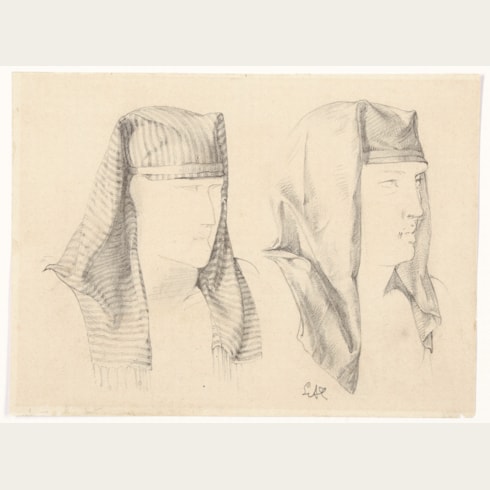Sir Lawrence ALMA-TADEMA
(Dronrijp 1836 - Wiesbaden 1912)
Three Studies of Drapery for The Contrary Oracle [recto]; Three Studies of a Standing Male Nude [verso]
The verso in pencil.
Inscribed (by the artist’s daughter Anna) with the artist’s initials LAT at the centre right, and inscribed for the Contrary Oracle at the lower left.
310 x 193 mm. (12 1/4 x 7 5/8 in.)
Vern Swanson has suggested that this drawing, part of a group of early drawings by Alma-Tadema, may be related to two paintings of Egyptian subjects, entitled Going to the Oracle and The Contrary Oracle, that the artist seems to have planned in 1857 and 1858, but which were either never executed, or else destroyed. (During his student years Alma-Tadema often destroyed or painted over paintings which he was unhappy with.) The studies of male nudes on the versos of this drawing provides a rare insight into Alma-Tadema’s working process. Such academic studies from the posed model indicate that, at least at this early stage in his career, the artist initially studied the figures in his compositions as nudes, before adding drapery.
Born in the Dutch province of Friesland, Laurens (later Anglicized to Lawrence) Alma-Tadema showed considerable talent as a draughtsman from a very early age. He enrolled in the Antwerp Academy in 1852, but left in 1857 to work as a studio assistant to the Dutch painter Louis (Lodewijk) de Taeye in Antwerp. He was encouraged by his master to study the early history of France and Belgium, and in particular the history of the Merovingians and the Franks, which the young painter began to use as source material for his own work. After three years with de Taeye, Alma-Tadema was invited to join the studio of Baron Henrik Leys, then one of the leading painters in Belgium, whom he assisted on a number of significant commissions, notably a cycle of frescoes for the Town Hall in Antwerp. The young Alma-Tadema made his first trip to London in 1862, and two years later exhibited an Egyptian subject picture at the Salon in Paris, winning a gold medal. At around the same time he met the influential art dealer Ernest Gambart, who engaged the painter on a contract to supply twenty-four paintings, and, beginning in 1864, began to exhibit his work each year in London. The success of these exhibitions led Gambart to engage the artist on a commission for a further forty-eight paintings. By this time Alma-Tadema was painting almost entirely Greek and Roman subjects, which account for the bulk of his output as a mature artist, and which established his international reputation. In 1865 he left Antwerp to settle in Brussels, where he worked with increasing success and recognition for the next five years.
Already well-known and admired in England, Alma-Tadema moved to London in 1870, where his career continued to flourish and his paintings were exhibited at Gambart’s gallery with much success. Naturalized in 1873 and elected an Associate of the Royal Academy three years later, he also began exhibiting at the Grosvenor Gallery in 1877. In 1879 Alma-Tadema became a full Royal Academician, and three years later was honoured with a large retrospective exhibition - numbering 185 paintings dated between 1840 and 1882, with many works lent by private collectors - at the Grosvenor Gallery. After this 1882 exhibition, however, his output lessened, so that he painted around six or seven pictures a year, including a small number of portraits; this was about half of his previous yearly production. The last decade of his career, however, also found him producing a large number of highly-finished drawings and watercolours. By this time a leading figure in the Victorian art world and one of the most famous artists in Europe, Alma-Tadema was the recipient of numerous honours and prizes, culminating in a knighthood in 1899 and the Order of Merit in 1905. Throughout most of his career, Alma-Tadema numbered all of his paintings sequentially with an ‘Opus number’ in Roman numerals, the last work being Opus CCCCVIII (or 408). Following his death in 1912 and burial in St. Paul’s Cathedral, a comprehensive memorial exhibition of his work was mounted at the Royal Academy in 1913.
Unusually for a Victorian artist, Alma-Tadema used figure drawings only rarely in preparing his paintings, preferring to paint directly from the live model. As the artist himself wrote in 1883, in a letter to his friend Georg Ebers, ‘in order to master oil painting I gave up everything else in 1859 and have but seldom touched a pen or pencil or water-colour.’ Indeed, drawings by the artist remain relatively scarce today, certainly by comparison with the drawn output of many of his artistic contemporaries. As one modern scholar has noted, ‘Drawings by Alma-Tadema are rare, and tend not to be preparatory works, but records of a head or pose done for pleasure in fine pencil, after perfecting them on the canvas or panel...However, a small number of rough studies for figures and compositions survives...’
Provenance
The artist’s brother-in-law, Sir Edmund William Gosse, London
By descent in the Gosse family until the 1920s or 1930s
Acquired by a private collector
Thence by descent until 2015.
Literature











